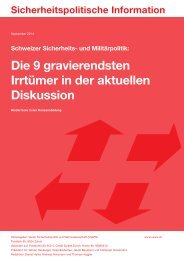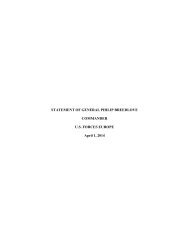FULLTEXT01
FULLTEXT01
FULLTEXT01
You also want an ePaper? Increase the reach of your titles
YUMPU automatically turns print PDFs into web optimized ePapers that Google loves.
TACTICAL THOUGHT<br />
2014 September 29 th<br />
Thus, he indirectly deals with Irregular Warfare as a function of a power struggle. He<br />
does not however, elaborate on the military-police labouring tasks or the difficulties of<br />
both overt and covert warfare. He has a clear political focus and not a “this is<br />
war/warfare” attitude. Finally, he does however discuss a “non-centre of gravity”<br />
theory, as a mark of the “Postmodern Maoist” Insurgency concept, argued so far as not<br />
to be understood in governmental as well as military circles.<br />
Result and conclusions<br />
The description is a predominantly explanatory description. The potential of explaining<br />
content covers aspects such as strategy, operational art and tactics. Fighting power<br />
factors are covered as are mainly physical and conceptual factors. The description<br />
explains characteristics with a lower-end violence focus. Attitude aspects are included.<br />
Participating actors are described with a focus on both sides of the parties. The<br />
description leans primarily on the political/civilian focus of the phenomena. The<br />
description is civilian comprehensive, but limited for the military part though it has<br />
clear explanatory articulations, with good understanding potentiality not needing any<br />
complementary sub-definitions.<br />
Gil Merom<br />
Gil Merom does not use the term Irregular Warfare but relies on the label Small Wars.<br />
He writes in the introduction of his well-known “How Democracies lose Small Wars”<br />
from 2003, as follows; “a small war has the following distinct characteristics: It<br />
involves sharp military asymmetry, an insurgent that fights guerrilla war, and an<br />
incumbent that uses ground forces for Counterinsurgency warfare. The incumbent can<br />
be an indigenous government that fights on its own or with external participation, or a<br />
foreign power that imposes itself on the population”. 494 The definition does not include<br />
moral aspects though the whole book extensively deals with this aspect. Merom also<br />
mentions explanations from Eliot A. Cohen, Charles Callwell, Loren B. Thompson,<br />
Andrew F. Keprinevich and Walter Laqueur.<br />
Result and conclusions<br />
The description is mostly an explanatory description with an umbrella character. The<br />
potential of explaining content covers aspects such as strategy, and operational art and<br />
tactics and the terms “Guerrilla War” and “Counterinsurgency War” indicate all aspects.<br />
Fighting power factors are covered only in physical factors, referring to “ground forces<br />
for COIN”. The description explains characteristics only for “military asymmetry”.<br />
Attitude aspects are not included. Participating actors are described with a focus on the<br />
incumbent. The description leans primarily on a military focus of the phenomena.<br />
Merom´s definitions and explanations focus mainly on the guerrilla aspect, for the part<br />
which is militarily weaker than an incumbent, (which can be either the existing<br />
government or a foreign power), which in turn uses ground forces for<br />
Counterinsurgency Warfare.<br />
494 Gil Merom, How Democracies lose Small Wars (New York: Cambridge University Press, 2003), p. 4.<br />
64





